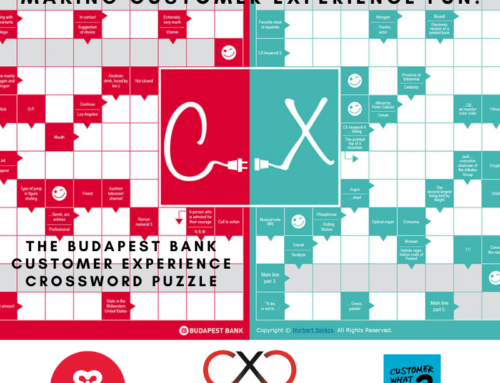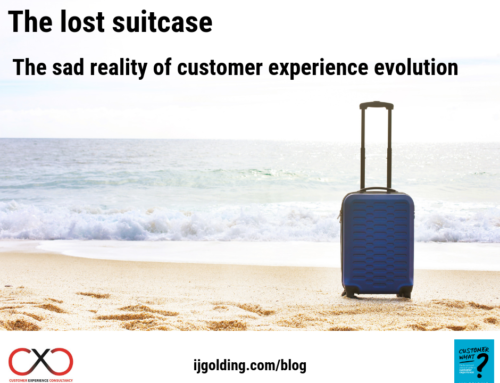
One of the six competencies required in the armory of all Customer Experience Professionals is defined by the Customer Experience Professionals Association (CXPA) as ‘Experience Improvement & Design’. To become a Certified Customer Experience Professional (CCXP), you will need to have knowledge of the following:
- Design thinking and customer co-creation approaches
- Process improvement methodologies and discipline
- Customer journey mapping and touchpoint analysis
Whilst process improvement is pretty well understood by many, Customer Experience Design is a skill set that has been less commonly deployed in organisations around the world. As I continue to prepare professionals in the industry to attain their CCXP accreditation, it is becoming increasingly evident that there is a need for continuing knowledge transfer in this area.
I am therefore delighted to be able to share this article with you – an article written by someone who is a specialist when it comes to Customer Experience Design. Juha Kronqvist is a senior service designer at Hellon and lecturer at Aalto University in Helsinki. I am sure you will find his article as fascinating as I did…..
Designers have been in the business of creating great experiences for the past century. If you look around you will notice countless objects, that all have been intentionally designed. With the rise of the service economy there is a new breed of ambitious professionals called Service Designers who focus on designing great customer experiences. They bring with them 3 essential skills from industrial product design and apply them in the service domain. These are empathy, insights and prototyping.
Empathy
Great design always starts with the question “why?”. Why does this service exist in this world? What value does it provide for the people we are offering it to? Why would the world be worse off without it? The key skill for uncovering these why questions is empathy towards people. It is a deep dive into the everyday lives of humans – the joys and pains that take place between those hours of waking up and going to bed.
In the design process empathy is the ability of taking the perspective of the customer and feeling with them as they experience services. It is not a mental exercise, but requires literally walking in the customer’s shoes through the service in question. At Hellon, we have been enjoying and suffering while going through hundreds of service experiences ranging from visiting disabled elderly people with home care services to feeling what it is like when the nurse is about to stick a needle into you during a blood sample test in a laboratory. Only through trying out the service you are able to really feel what the user is feeling- to empathise. Reading about it in a powerpoint deck from your research agency doesn’t do it.

Getting a blood sample taken at a laboratory
However, empathy is not only about feelings. It is deep understanding of the world-view of the customer and breaking with convenient stereotypes (convenient because they save time). Many times our assumptions as professionals who are tasked with developing services do not hold when we view them from the other side of the fence. We need to look carefully at what people actually do, how they behave in the service situation, what makes them smile and when do they frown. It’s often the small things that make or break an experience. These are the things that participants don’t mention in surveys or focus groups.
When it is not possible or practicable for us to observe people face to face we ask them to record their experience. For example using disposable cameras and we then interview them on their experiences afterwards. In this way, we can see what they see, creating an real understanding of what matters to them most. Essentially, it allows the Service Designer to ask the right questions, to the right people, at the right time.
Insights
Traditional market research focuses on finding “truths” through asking hundreds of customers to fill out a survey or rate a service. This will tell you if a service is “good” or “bad”, but you will not understand why. Instead, service designers focus on a smaller sample, perform a deep dive into their lives and arrive back on the surface with a treasure of insights that can be used in not only making an experience great but, even more importantly, differentiating it from the competition. Companies often spend large amounts in technologies or on service aspects that they assume the customer would like. Only for us to find that is a waste of money and different, often smaller, cheaper things ‘make’ the good experience instead.

Market research vs Design research (Polaine, Løvlie & Reason 2013)
Arriving at insights is a creative process that combines empathic observations (I saw this) with the experience (I know this) of the designers. Through working cross-disciplinarily with service providers from various fields designers gain a wealth of experiences that they can use in whatever client they are working with. What can we learn from the internet services from banking that we can utilise in designing healthcare services? How might we redesign an energy service using insights gained from working with a casino?
While working with a large nordic pharmacy chain we noticed that a great amount of time of the customers is spend waiting idly for reaching the front of the queue at the prescription desk. At the same time many customers mentioned in interviews that they often remember a product that they need only after arriving back at home. This insight led us to redesign the prescription desks to be smaller and place them all around the pharmacy space. Now the employees can not only hand out the prescription but also walk with the customer to shelves with other products. The new design not only increased the customer experience and the sales of non-prescription items, but also the employees enjoyed a deeper connection with their customers. This insight (and a few more) gained us the first prize for ‘Result-driven Service Design’ at the global service design awards in NYC earlier this month for our People’s Pharmacy.

A newly designed pharmacy
Prototyping
Even the greatest insights are only educated guesses of what might work. In order to validate our ideas we need to test them before allocating resources to make them real.
Prototypes are visualised service proposals that make their value concrete in a form or another. They are quickly and cost efficiently made rough models of a concept (mock-ups, storyboards, customer journeys or interfaces). They are not complete descriptions, but together they build the proposed experience enough for it to be evaluated against user needs. For their viewers they offer an understandable and relatable view on how the solution could feel like. They allow for testing even the more wild ideas to see how the customers react to them.
Prototyping is essentially a method for controlling risks: by testing an idea before committing on its production we reduce the possibility for investing in something that the customers do not want to have. With prototyping the service concept can be validated and further refined.
Once we have tested and refined our prototype, we can be more confident that it will succeed in the market place. It makes it easier for the organisation to seek consensus and resources for investing as there is evidence of the customer experiences created by the new services.

Prototyping new prescription desks
Design is in the details
Of course, it is not only designers who utilise these traits, but they can be learned by professionals from other fields. Already, businesses are starting to train their personnel in design skills with the help of service design agencies. However, an extensive design education gives you the essential tools for creating great customer experiences from idea to implementation. If you spot a talented service designer, hold on to them. They can prove to be more valuable than gold.
Hellon is the leading service design consultancy in Scandinavia. Currently Hellon has offices in Helsinki and in London. Since 2009 Hellon has been creating unique and successful customer experiences for global companies like Nordea Bank, KONE, ABB and Teliasonera. The work of Hellon is always based on the essential Nordic values; honesty, smartness, courage and empathy.






[…] Sourced through Scoop.it from: https://www.ijgolding.com […]
Summarises our business quite well. Empathy is key to designing service that is relevant.